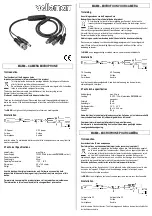
room, try backing the microphone up a couple of feet.
Drums
Although the N22 may work well for traditional ribbon mic placement
techniques like overheads or room mics, it is particularly well-suited
for more close-up applications like drum underheads, kick or snare.
On snare drum, the N22 really brings some character to the table that
will be hard to find in an SM57. Use the null plane of the figure-of-8 to
reject the hihat. If you have a drummer that plays very well balanced (
yes,
this might be rare
), position the N22 so that its back side picks up the
hihat as well.
{
PRECAUTIONS
}
Most ribbon microphones need little, if any, maintenance. Given proper
care they last for decades. Bing Crosby’s personal RCA-44BX (now in
the collection of the Pacific Pioneer Broadcasters in Hollywood) sounds
as good today as it did when he recorded his radio broadcasts in the
1940s.
A few simple precautions will help you to keep your AEA N22 working
well for life.
Phantom Power
Although the N22 needs a standard 48V phantom-power source to
operate, you should still make sure that phantom-powered is turned off
before plugging and unplugging the microphones. The loud pops that
occur when the microphone is plugged in with phantom-power engaged
can damage speakers, headphones, and ears. Since passive ribbon
microphones or other transformer-coupled microphones are particularly
sensitive to phantom-power, it is recommended to make disengaging
phantom-power before plugging and unplugging a habit.
Wind Gusts
A second and equally important rule is never to blow directly into a
ribbon microphone to test it. Strong air turbulence can stretch the
ribbon diaphragm and while it may not break, it will nonetheless
significantly degrade the microphone’s performance. The ribbon in the
N22 is highly protected by multi-layered screens and cloths to provide
9
































